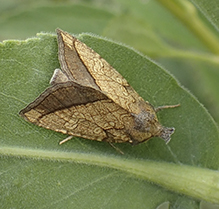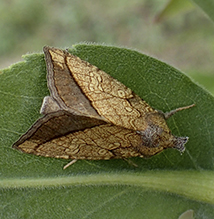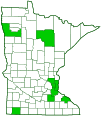rigid sunflower borer
(Papaipema rigida)
Conservation • Description • Habitat • Ecology • Distribution • Taxonomy
|
||||||||
| Hodges # | 9503 |
|||||||
Conservation Status |
||||||||
| IUCN Red List | not listed |
|||||||
| NatureServe | N5 - Secure SNR - Unranked |
|||||||
| Minnesota | not listed |
|||||||
Description |
||
Rigid sunflower borer is a mid-sized, late season, borer moth. It occurs in the United States from New Hampshire to northern Virginia, west to Minnesota and Iowa, and south along the Appalachian Mountains to North Carolina. There is a single record of it in Oklahoma, far outside of its known range. It also occurs in southern Canada from New Brunswick to Ontario. It is not common in Minnesota. The larvae feed on the leaves of sunflowers and related species, including Jerusalem artichoke, paleleaf woodland sunflower, thinleaf sunflower, common sneezeweed, golden alexanders, and smooth oxeye. Adults are active from August to October, though individuals have been reported as early as late July. They are found in meadows and woodlands where its food plants grow. Rigid sunflower borer was common in the northeast and Midwest as recently as the 1970s. Its numbers have been seriously reduced due to overgrazing of its host plants by deer. Adults have a 1¼″ to 1 7⁄16″ (31 to 36 mm) wingspan. The ground color is pale straw yellow. The head is mostly purplish gray, but it is straw yellow on top. On the upper side of the thorax, there is a loose tuft of hairs and a pair of hair-covered, scale-like plates (patagia) that cover the wing bases. The tuft and the patagia are purplish. The forewings are moderate sized and triangular. Each forewing is pale straw yellow with heavy brown speckling from the base to the postmedial (PM) line. Beyond the PM line it is shaded purplish brown except at the wingtip, where it is straw yellow. There is also purplish-brown shading above the antemedial (AM) line. The AM line is vaguely W-shaped. The inner, downwardly pointing lobe is short and rounded, and the outer lobe is long and is sharply pointed. The median line is brown and W-shaped. The PM line is slightly curved to almost straight, not wavy. The AM and PM lines are dark brown, bold, and doubled – there is an indistinct, lighter brown line beyond the AM line and another before the PM line. The subterminal (ST) line is dark brown with a crescent-shaped lobe between each vein. The shading beyond the ST line is often slightly lighter. There are two spots (orbicular spot and claviform spot) in the upper median area and a kidney-shaped spot (reniform spot) in the lower median area. Each spot is bordered with a dark brown line and is filled with the ground color, not with white. The hindwings are pale yellowish, almost white. |
||
Size |
||
Wingspan: 1¼″ to 1 7⁄16″ (31 to 36 mm) |
||
Similar Species |
||
Habitat |
||
Meadows and woodlands |
||
Ecology |
||
Season |
||
One generation per year: August to October |
||
Behavior |
||
Adults rarely venture far from their host plants. They will come to lights but only if those lights are placed near their host plants. |
||
Life Cycle |
||
|
||
Larva Food |
||
Leaves of sunflowers and related species, including Jerusalem artichoke, paleleaf woodland sunflower, thinleaf sunflower, common sneezeweed, golden alexanders, and smooth oxeye. |
||
Adult Food |
||
Flower nectar |
||
Distribution |
||||
|
Sources |
|||
| 12/1/2023 | ||||
Occurrence |
||||
Not common |
||||
Taxonomy |
|||
Order |
Lepidoptera (Butterflies and Moths) | ||
Superfamily |
Noctuoidea (Owlet Moths and Allies) | ||
Family |
Noctuidae (cutworm moths and allies) | ||
Subfamily |
Noctuinae (cutworms and dart moths) | ||
Tribe |
Apameini (arches) | ||
Genus |
Papaipema | ||
Synonyms |
|||
Gortyna rigida Hydroecia rigida |
|||
Common Names |
|||
rigid sunflower borer rigid sunflower borer moth |
|||
Glossary
Antemedial (AM) line
A thin line separating the basal area and the median area of the forewing of Lepidoptera.
Claviform spot
A club-shaped, wedge-shaped, or round spot in the upper median area, between the orbicular spot and the inner margin, connected to the AM line, on the forewing of many moths.
Orbicular spot
A circular spot or outline in the upper median area near the antemedial line on the forewing of many moths.
Patagium
In some mammals, the membrane between the forelimb and the abdomen that assists in flying or gliding. In Lepidoptera, one of a pair of hair-covered, sausage-shaped, scale-like plates on the thorax that cover the wing bases. Plural: patagia.
Postmedial (PM) line
A thin line separating the median area and the postmedial area of the forewing of Lepidoptera.
Reniform spot
A kidney-shaped spot or outline in the lower median area near the PM line on the forewing of many moths.
Visitor Photos |
|||||
Share your photo of this insect. |
|||||
| This button not working for you? Simply email us at info@MinnesotaSeasons.com. Attach one or more photos and, if you like, a caption. |
|||||
Babette Kis |
|||||
Papaipema rigida (rigid sunflower borer) I've only seen them on the undersides of sunflower leaves, in this case, a native prairie sunflower. Photos taken at Barnes Prairie, Racine Co., WI on August 31, 2020. |
 |
||||
 |
|||||
MinnesotaSeasons.com Photos |
|||||
|
|||||

Slideshows |
||

Visitor Videos |
|||
Share your video of this insect. |
|||
| This button not working for you? Simply email us at info@MinnesotaSeasons.com. Attach a video, a YouTube link, or a cloud storage link. |
|||
Other Videos |
|||
| Rigid Sunflower Borer Moth (Noctuidae: Papaipema rigida) Lateral View Carl Barrentine |
|||
About
Aug 17, 2011 Photographed at Fisher, Minnesota (17 August 2011). Go here to see other (and better) images of this specimen: http://bugguide.net/node/view/564312 |
|||
| Sunflower Stem Borer. What They Look Like, and What They Do Inside a Stem. Midwest Gardener |
|||
About
Jul 27, 2017 We recently had stem borers on our Yacon. I'm just a curious guy, so I had to see if we had them on our sunflowers too. Sure enough I found one, and it did a whole lot of damage while it was in there. Apparently the larvae are cannibalistic, so many times you will only find one, because they ate the others. I'm not exactly sure what I'm going to do with what I've learned about them this year, but at least I won't' be going on oblivious to it. |
|||


Created: 12/1/2023
Last Updated:

